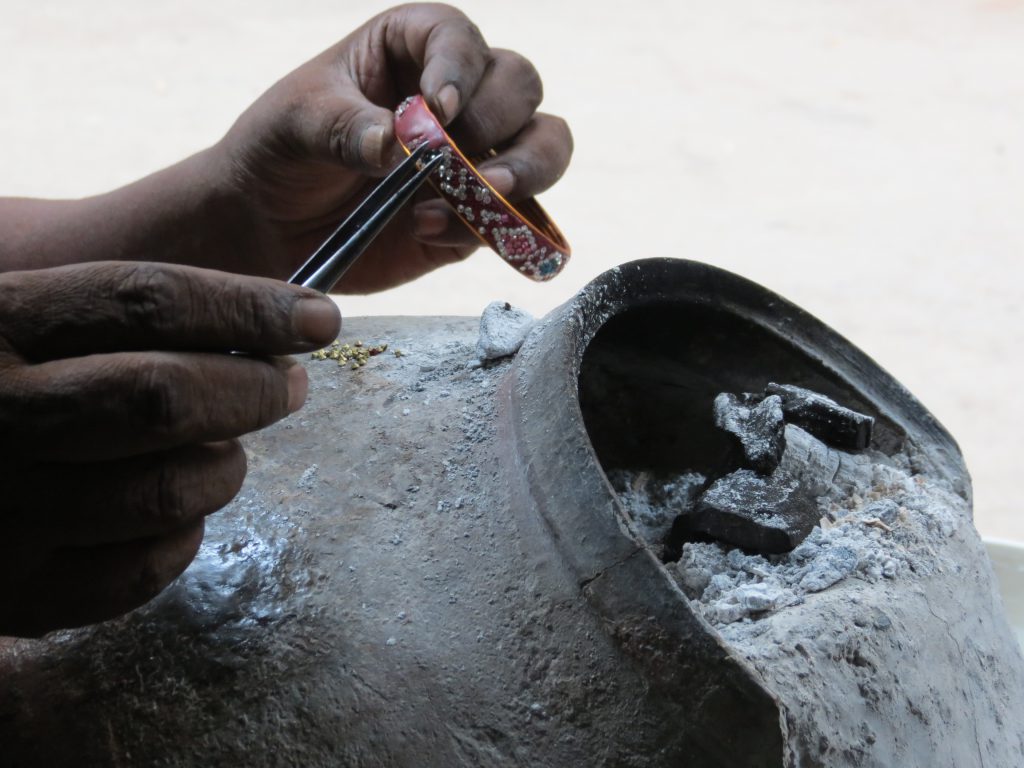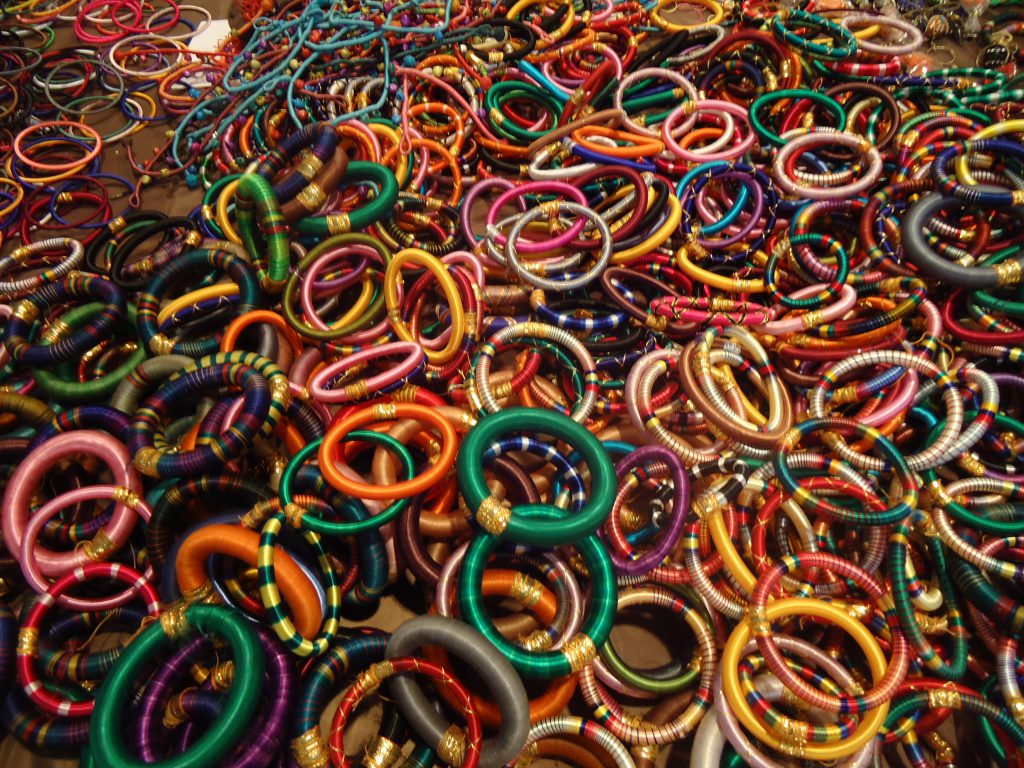‘Incredible India’ is a befitting tagline to the country, one which varies in culture, tradition, art forms, attire, and even ornaments like no other. Bangles, the thin, often rigid ornament similar to a solid bracelet in Indian culture has innumerable significance. Bangles are considered the symbol of ‘the complete woman’ or ‘Saubhagya’as a man offers his lady bangles, of varying designs and quantities.
The word Bangle is derived from the Hindi word ‘bungri’ means glass, and are traditional ornaments mostly worn by women all over South Asia in countries such as Nepal, Pakistan, and Bangladesh besides India. Bangles have a traditional value and it is considered inauspicious to be bare-handed especially for a married woman for most Indian weddings. In North India, the bride generally wears glass bangles, with the bangles themselves symbolizing the Suhaag (love) for the husband and their prosperity in married life afterward.
In certain parts of India, like Punjab for instance. Men too wear bangles as part of custom with the father of the bride presenting the groom with a gold ring, called a Kara (steel or iron bangle). The Punjabi woman on her wedding day wears a set of bangles called Chooda which is a set of white and red bangles with stonework. According to Sikh tradition, a woman is not supposed to buy the bangles she wears. Bangles are part of traditional Indian jewelry and thus they are still preferred at occasions such as marriages and festivals, though young girls still tend to wear them, and toddlers also sometimes wear bangles, often made of gold or silver. In Bengal and Odisha, married women wear white bangles made of shells. Bengali bangles made by fusing thin gold strips with handmade crafts on bronze bangle are very special to women in Bengal.
History
The bangles are usually made from metal (copper, silver, gold, iron, etc.), wood, plastic, and glass. Archaeologists have excavated bangles made of various metals from various parts of India with highly ornate bangles dating back to the Mauryan Empire and gold bangles excavated from the historic site of Taxila, proving just how far back the tradition goes.
A bronze figure of a dancing girl standing with one arm at her hip, the other arm with a collection of bangles, is a famously known artifact excavated fromMohenjo-Daro, a piece that shows the antiquity and prominence of wrist ornaments in Indian culture. Wearing ‘Kanganas’ (slightly thicker ornate bangles) is a common trope shown in various mythic and epic stories, another strong case that not only women but also men have been adorning their arms with bangles since ancient times in India
All the pre-Vedic era and post-Vedic era bangles were purely cosmetic until the medieval period. Back during this time, bangles were introduced, tying ritualistic beliefs and considered as a symbol of marriage.
Any material like terracotta, gold, silver, Iron that lent itself to craftsmanship and could be worked on by a smith were used to make bangles and the legacy of wearing bangles was marked in the history of Sindhu Saraswathi civilization.
The legends about bangles are perhaps not as old as the Vedas but might come close with a lot of ancient jewelry dating all the way back containing some form of the bangle and as cultures evolved and transformed bangles have morphed into their own different kinds of roles in different parts of Indian customs. For instance, bangles made of gold are considered extremely auspicious especially for brides in south India while in Gujarat and Rajasthan, ivory bangles or ‘Hooda is all the rage with the bride’s maternal uncle giving her the chooda in a ‘ceremony’ called ‘mameru’, along with a bridal silk saree. The bridal chooda of Maharashtra is a mix of green glass bangles in odd numbers along with golden ones called patlya and carved kadas (another thick type of bangle) called tode. Punjabi brides wear 21 ivory bangles in white and red bangles (chooda) for a period of at least 40 days which are also gifted by the maternal uncle of the bride and with a Bangle wearing ceremony held on the morning of the wedding day.
In south India, the ceremony called ‘Valaikaappu’ is performed during the seventh month of pregnancy by adorning the pregnant woman in the family with bangles. various types of glass bangles with different colours are stacked on her hands in the function.
The significance of colours
In Indian culture, the colours of bangles also have their own significance in Indian tradition. For Indian women, bangles are not just mere ornaments. It is a tradition to wear bangles after marriage, symbolizing health, luck, and prosperity. Bangles are more than accessories for Indian women. Traditionally, they are more often than not, a part of their identity. Red signifies energy and prosperity, while green denotes good luck and fertility. Yellow bangles are meant for happiness, white is for new beginnings and orange is for success. Silver bangles denote strength and gold bangles are the ultimate symbol of fortune and prosperity.
Firozabad-The ‘Suhag Nagari’
Glass bangles are considered as a symbol of being a married woman or ‘Suhagan’ in the local language, Hindi. Firozabad in UttarPradesh has earned the name ‘Suhag Nagari’ which means the city of married women where the married women wear bangles as a symbol of prosperity. So, the city is known for its Bangle-making and selling businesses.
As Firozabad is famous for glass bangles, the Laad Bazaar or Choodi Bazaar in Hyderabad is a historic world-famous market for bangles and is famous for various types of pearl bangles. It is located on one of the four main roads from the Charminar. Moradabad city in India is the largest producer of bangles.
Nakkavanipalem, a tiny village near Narsipatnam in was once a place where skilled bangle workers were there widely.
Apart from India, Hyderabad city in Pakistan is also famous for the production of glass bangles. The bangle manufacturing, be it in any material ranging from metal to rubber or glass it is a tedious process as it requires ultimate precision. The safety of workers who make these bangles are often a cause of concern as well, with workers in this industry being mostly women or children who work under high temperature, in dark rooms, and in crouched positions for long periods.
Bangles are glorified by the poetic symbolizations in Indian literature and are marked as the epitome of feminine grace.
Apart from the socio-cultural significance, Indian women love their bangles. Womenfolk love to enhance their feminine grace and beauty with the help of bangles that are available in a variety of forms. The artificial bangle industry researches novelty and they bring out the bangles that sparkle in myriad hues. The Indian bangles continue the undiminished sway while the latest fashion trends are there on the way. The story never ends here. It goes on like the umpteen varieties of bangles that you see in festival grounds, bangle markets, and other fancy stores that lure the heart and soul of every Indian woman.
Read also
Watch on YouTube



